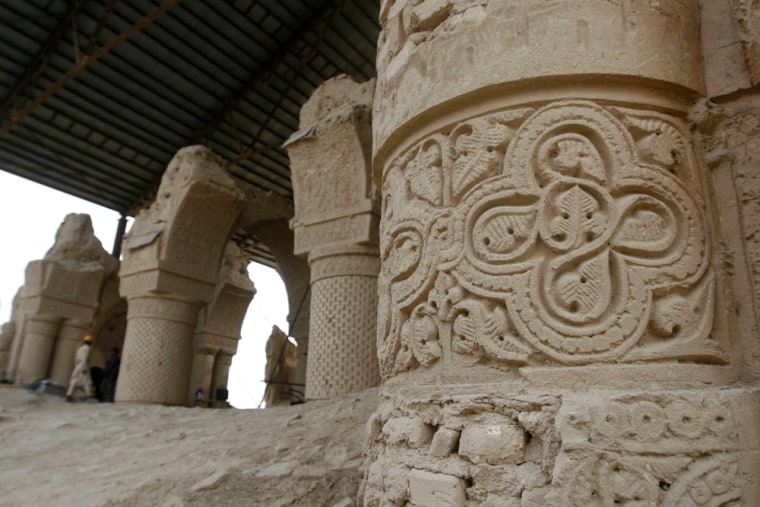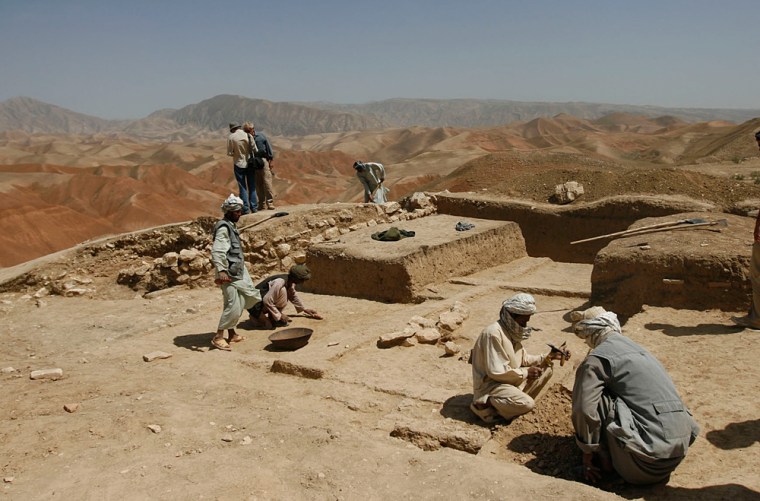Centuries-old shards of pottery mingle with spent ammunition rounds on a wind-swept mountainside in northern Afghanistan where French archaeologists believe they have found a vast ancient city.
For years, villagers have dug the baked earth on the heights of Cheshm-e-Shafa for pottery and coins to sell to antique smugglers. Tracts of the site that locals call the "City of Infidels" look like a battleground, scarred by craters.
But now tribesmen dig angular trenches and preserve fragile walls, working as laborers on an excavation atop a promontory. To the north and east lies an undulating landscape of barren red-tinted rock that was once the ancient kingdom of Bactria; to the south a still-verdant valley that leads to the famed Buddhist ruins at Bamiyan.
Roland Besenval, director of the French Archaeological Delegation in Afghanistan and leading the excavation, is sanguine about his helpers' previous harvesting of the site. "Generally the old looters make the best diggers," he said with a shrug.
A trip around the northern province of Balkh is like an odyssey through the centuries, spanning the ancient Persian empire, the conquests of Alexander the Great and the arrival of Islam. The French mission has mapped some 135 sites of archaeological interest in the region, best known for the ancient trove found by a Soviet archaeologist in the 1970s.
The Bactrian Hoard consisted of exquisite gold jewelry and ornaments from graves of wealthy nomads, dated to the 1st century A.D. It was concealed by its keepers in the vaults of the presidential palace in Kabul from the Taliban regime and finally unlocked after the militia's ouster.
The treasure, currently on exhibition in the United States, demonstrates the rich culture that once thrived here, blending influences from the web of trails and trading routes known as the Silk Road, that spread from Rome and Greece to the Far East and India.
But deeper historical understanding of ancient Bactria has been stymied by the recent decades of war and isolation that severely restricted visits by archaeologists.
"It's a huge task because we are still facing the problem of looting," said Besenval, who first excavated in Afghanistan 36 years ago and speaks the local language of Dari fluently. "We know that objects are going to Pakistan and on to the international market. It's very urgent work. If we don't do something now, it will be too late."
Looting was rife during the civil war of the early 1990s when Afghanistan lurched into lawlessness. Locals say it subsided under the Taliban's hardline rule, but the Islamists' fundamentalism took its own toll on Afghanistan's cultural history. They destroyed the towering Buddha statues of Bamiyan chiseled more than 1,500 years ago, and smashed hundreds of statues in the national museum simply because they portrayed the human form.
The opening up of Afghanistan did little to curb the treasure hunters. British author Rory Stewart, who made an extraordinary solo hike across the country in 2002, wrote how poor tribesmen were systematically pillaging the remains of a lost ancient city dating back to 12th century around the towering minaret of Jam in western Afghanistan.
State control is a little more pervasive in Balkh but still patchy. The provincial culture authority says it has just 50 guards to protect historical sites across an area nearly the size of New Jersey.
Saleh Mohammad Khaleeq, a local poet and historian serving as the chief of the province's cultural department, said the guards ward off looters, but concedes the only way to safeguard Afghanistan's rich heritage is through public education.
"People are so poor. They are just looking for ways to buy bread. We need to open their minds as they don't know the value of their history. We have to give them that knowledge and then they will protect it," he said.
Villagers hired as laborers at Cheshm-e-Shafa recall how they too used to be among hundreds of locals who would scavenge the site they are now paid 230 afghanis (US$4.60) a day to excavate.
"During the civil war everyone was involved," said Nisarmuddin, 42, who covered his face with his turban to block the dust that a stiff breeze whipped across the mountainside.
Nisarmuddin, a farmer who like many Afghans goes by one name, said people used to keep their finds secret so the local militia commander would not claim them. They could sell items of ancient pottery and glass for a few dollars to antique dealers in the city of Mazar-e-Sharif, which lies an hour's drive down a bumpy track through the desert.
One of the Afghan culture officials working at the Cheshm-e-Shafa excavation was clearly anxious that media coverage could bring unwanted attention to the site, where archaeologists have uncovered a 6-foot-tall (2-meter-tall) anvil-like stone believed to have been an altar at a fire temple originating from the Persian Empire period around the 6th century B.C.
"Hezb-e-Islami and Taliban and other extremists might use explosives and blow up this stone," said archaeology department official Mohammed Rahim Andarab.
Many archaeologists remain wary of working in Balkh as Islamic militancy seeps into new regions of the country. Yet the sheer breadth of history to be unearthed is enough to lure Besenval and his colleagues.

They are also restoring an ornate 9th century A.D. mosque. Its stout, half-buried columns, decorated with abstract floral and geometric patterns in stucco, reflect local art but also influences from central Asia, Buddhism and Persia. Chahryar Adle, a Frenchman of Iranian descent with long experience in Afghanistan, said the mosque of Noh-Gonbad, or Nine Cupolas, is the oldest in the country and "undoubtedly it is one of the finest in the world of this period."
French archaeologists have a long association with the region. They first visited in 1924 to excavate a fortress in the nearby town of Balkh. They hoped to find an ancient city of Alexander, whom history recounts married a local princess, Roxanne, in Bactria, in 327 B.C., but left disappointed.
The mirage of Alexander also lurks over Cheshm-e-Shafa, about 20 miles (30 kilometers) away. The site had a strategic location at the southern entry point into Bactria with fortifications circling an area of about 1,000 acres (400 hectares), and its network of mountaintop lookout towers suggest it was well defended. A flat field the size of several football pitches that may have been a parade ground or barracks lies on the plain below. And the local nickname "City of Infidels" also suggests a foreign occupation at some time.
So could this have been Alexander's redoubt in Bactria, where he met the local princess Roxanne? The archaeologist allowed himself a rare foray into the realms of speculation.
"Who knows? Maybe they married in Cheshm-e-Shafa," Besenval said, smiling.
